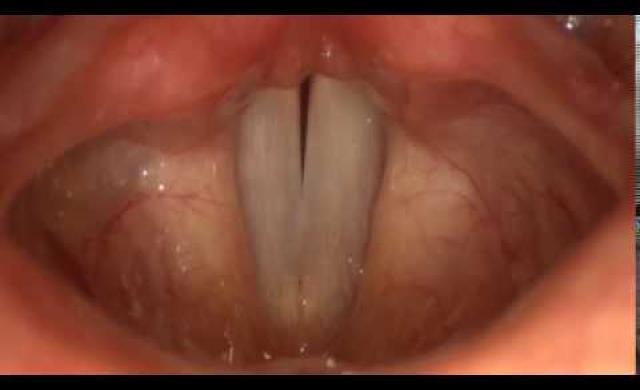Whether you see us in-person or by Video Visit, we're here for you. See how we're keeping you safe.
An examination of the internal structures of the larynx, including the vocal folds, is called laryngoscopy. There are three principal ways to perform laryngoscopy, reviewed below. Each of these may be appropriate in certain circumstances, but none of these methods alone can evaluate the rapid vibration of the mucosa that serves to produce voice. This evaluation requires a technique called stroboscopy.
The first and oldest (having been available for over a century) method of examining the larynx involves inserting a small angled mirror, such as a dentist might use, into the back of the mouth. This mirror deflects a beam of light down onto the vocal folds and reflects the image of the vocal cords back up to the examiner. This method provides a good view of the vocal folds, and likely the most accurate picture with respect to color. However, it is not possible to magnify the view or record the examination. For these reasons, and because it requires a certain skill and lightness of touch, it is not often used today.
This is the most widely available method of examining the vocal folds. An endoscope measuring less than 4mm in diameter is inserted through one nostril and guided through the nose to the back of the throat, until it lies just above the larynx. The flexible fiberoptic laryngoscope is the workhorse endoscope in ear, nose and throat medicine – no otolaryngologist’s office is without one. Its advantages include ease of use and general availability, and the capability to examine the larynx during a variety of tasks - such as swallowing, connected speech, and singing. This is very important in the evaluation of many neurologic disorders such as spasmodic dysphonia and vocal fold paralysis. However, flexible endoscope optics are generally inferior to that of a rigid endoscope. The view can appear grainy or pixilated, and may not permit precise differentiation among masses of the vocal cords.
Distal Chip Laryngoscopy
Flexible fiberoptic laryngoscopy is gradually being abandoned in favor of flexible distal chip endoscopy. In distal chip endoscopy, the optical fibers are replaced by a digital chip at the tip of the scope which moves the image quality toward the standard of the rigid laryngoscope (see below), making flexible stroboscopy practical and informative.
This method operates along the same principles as a mirror, except that a rigid endoscope is inserted into the mouth in its place. This carries with it its own light source, so it allows the examiner to combine the best element of the mirror, optical quality, with the ability to record and magnify the examination, and perform stroboscopy. This makes it the best means to evaluate subtle problems. It requires more technical expertise than the flexible scope.
In stroboscopy, a microphone, usually applied to the skin of the neck overlying the larynx, registers the frequency of the voice. This is connected to a strobe light, which flashes just slightly out of sync with the frequency, offering a video image of the vibration of the vocal fold, known as the mucosal wave. Because this vibration is the source of sound, stroboscopy is the best method to evaluate masses or irregularities of the vocal fold. However, stroboscopy is technically more difficult than simple endoscopy, and interpreting the examination is not always straightforward. A practiced eye is necessary to spot subtle abnormalities or small lesions.
Stroboscopy is not the same as laryngoscopy. Stroboscopy refers to the use of a specific type of light, and not the type of instrument used to look at the vocal folds. Without a synchronized strobe light, a look at the larynx is simply a laryngoscopy, regardless of whether a flexible or a rigid endoscope is used.
